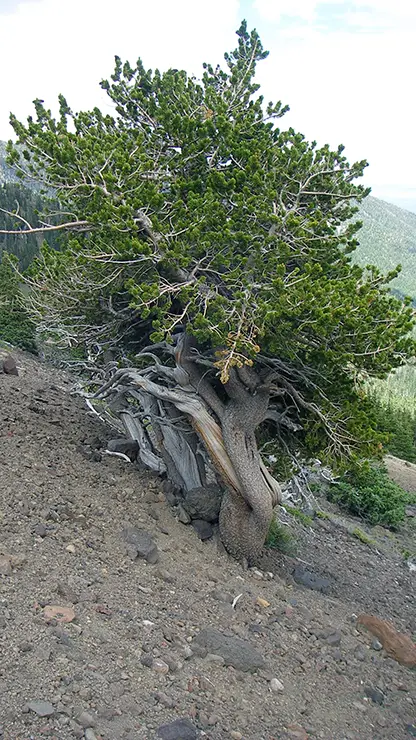

Bristlecone Pine
Pinus aristata Engelm.
Bristlecone Pine
Pinus aristata Engelm.
“Bristlecone Pine is a very long-lived tree, with some trees estimated at over 5,000 years old.”– Economic and Ethnobotanical Uses
 Whole bristlecone pine tree (Mendoza, 2009)
Whole bristlecone pine tree (Mendoza, 2009)


Summary
Taxonomy
(How things are grouped and categorized based on shared traits.)- Kingdom: Plantae
- -Phylum: Streptophyta
- –Class: Equisetopsida
- —Subclass: Pinidae
- —-Order: Pinales
- —–Family: Pinacea
- ——Genus: Pinus
- ——-Species: aristata
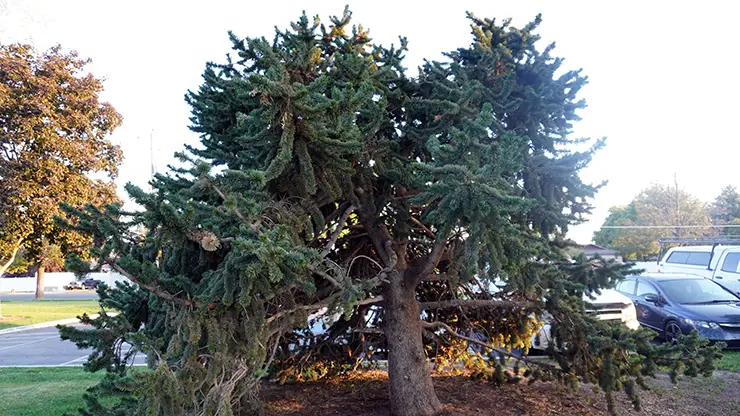
Taxonomic History:
Pinus aristata was described by George Engelmann (1862) under its current name. However, even Englemann was uncertain where to place it taxonomically, as he also once considered it to be a variety of Pinus balfouriana (var. aristata; Parry & Engelmann, 1862).
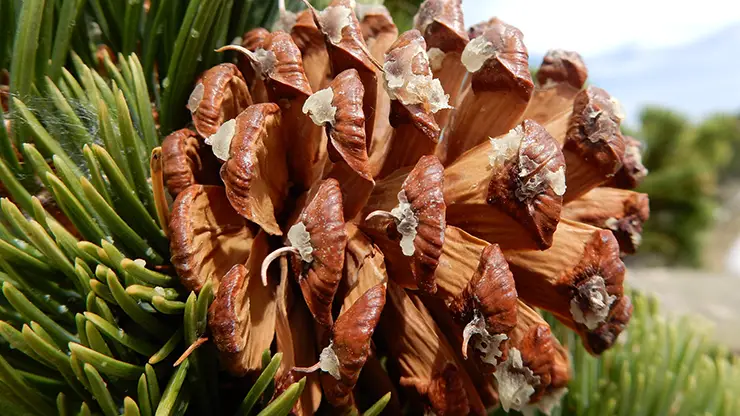
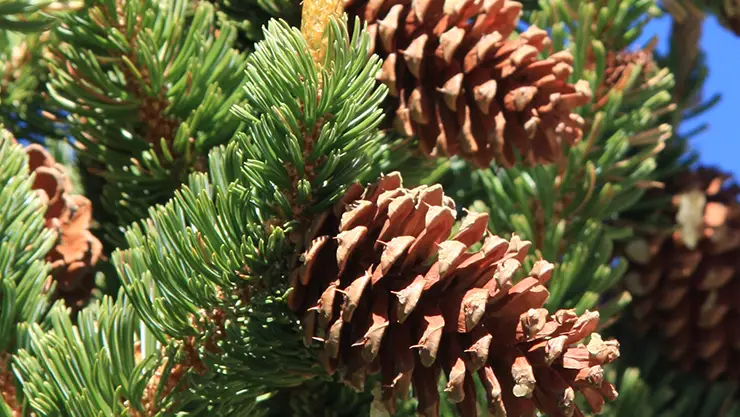

Identification Tips
Bristlecone pine can be identified by needles that grow in a dense all-round pattern. The tree usually has a scraggly and twisted appearance, which contrasts the columnar appearance of most pines. It is very difficult to tell the difference between Pinus aristata and the Great Basin Bristlecone Pine found in Utah, Nevada, and California (Pinus longaeva). However, Pinus aristata has longer, sharper needles that are a darker green-blue and have a long narrow groove on the back and the cones have a long bristle that is 6-10 mm long, whereas P. longaeva’s needles are yellow-green and have cone bristles much shorter (1-6 mm) (Kral, 2020b).

Fun Fact!
Bristlecone Pine is a very long-lived tree, with some trees estimated at over 5,000 years old.

Fun Fact!
One individual contained more than 2,400 tree rings when a core was extracted to measure its age in 1992 (Brunstein, 1993). The size of tree rings indicates the stress a tree experienced in a year, providing a snapshot of the general conditions of the area for the last 2,400 years.

Fun Fact!
Pinus aristata is very slow growing.
Native Range:
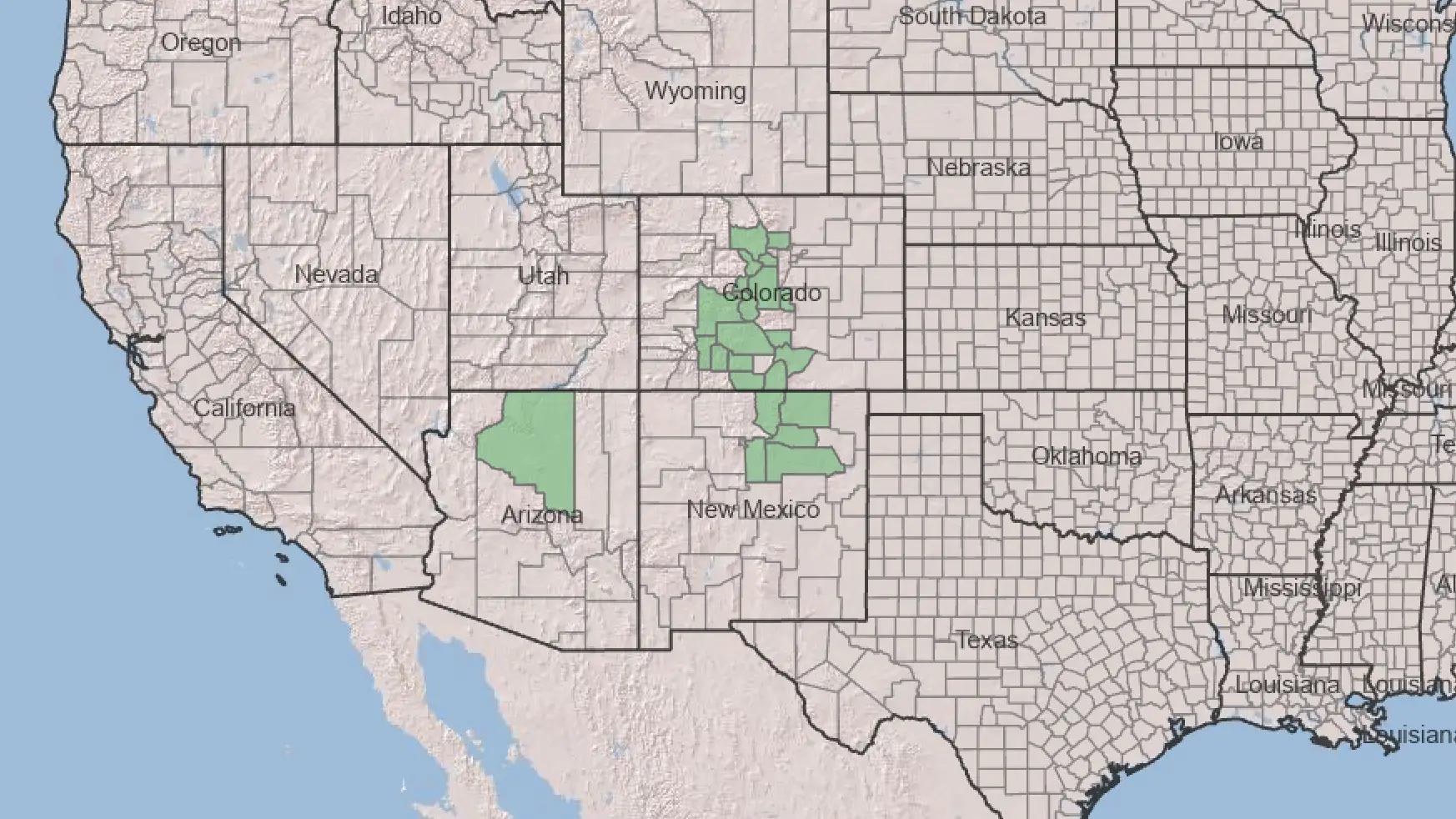

Native

Introduced
Plant Ecology/Habitat
Pinus aristata typically grows on steep slopes in high montane environs but can survive on level ground as long as it drains well. It thrives in areas that receive 34-45 inches of rain per year and tolerates cold climates above 10,000 feet elevation. They produce seed regularly, and many of their seeds are eaten by rodents (Fryer, 2004).

Economic or Ethnobotanical Uses
- The Shoshoni applied the Bristlecone’s heated resin to sores and boils (Train et al, 1941).


Conservation Status
Pinus aristata is considered vulnerable overall and imperiled in Arizona (NatureServe, 2024). Its status may continue to decline as it was recently shown to be susceptible to the mountain pine beetle which can kill whole stands of trees (Bentz et al. 2021).
Additional Resources

References

- Armstrong, H. (2025). Pinus aristata. [Photograph]. Orem City Center Park, Orem, UT.
- Bentz, B. J., Hansen, E. M., Vandygriff, J. C., Stephens, S. S., & Soderberg, D. (2021). Rocky Mountain bristlecone pine (Pinus aristata) is a confirmed host to mountain pine beetle (Dendroctonus ponderosae). Western North American Naturalist, 81(1), 19-26.
- Brunstein, F. Craig. (1993). Colorado’s ancient bristlecone pines. Open-File Report 93-250. Denver, CO: U.S. Department of the Interior, Geological Survey. 5 p. [47929]
- Dcrjsr. (2010). Branch of young Bristlecone pine. [Photograph]. Wikimedia Commons. https://upload.wikimedia.org/wikipedia/commons/0/07/Bristlecone_pinus_longaeva_bristly_cone.jpg
- Fryer, J. L. (2004). Pinus aristata. Fire Effects Information System (FEIS). https://www.fs.usda.gov/database/feis/plants/tree/pinari/all.html
- Kral, R. (2020a). Pinus aristata. In Flora of North America vol. 2. http://floranorthamerica.org/Pinus_aristata
- Kral, R. (2020b). Pinus longaeva. In Flora of North America vol. 2. http://floranorthamerica.org/Pinus_longaeva
- Lavin, M. (2016). Pinus aristata. [Photograph]. Flickr. https://www.flickr.com/photos/plant_diversity/27174844983
- Mendoza, A. (2009). Pinus aristata. [Photograph]. Flickr. https://www.flickr.com/photos/39039456@N07/3799501297/
- NatureServe. (2024). NatureServe Network Biodiversity Conservation Status Data accessed through NatureServe Explorer 2.0 [web application]. NatureServe, Arlington, Virginia. https://explorer.natureserve.org/Taxon/ELEMENT_GLOBAL.2.150471/Pinus_aristata Accessed 3 Aug 2024.
- Parry, C. C. & Engelmann, G. (1862). Supplements to the enumeration of plants of Dr. Parry’s collection to the Rocky Mountains – Supplement 1 – Coniferae. Amer. J. Sci. Arts., ser. 2 34:331.
- POWO (2024). Plants of the World Online. Facilitated by the Royal Botanic Gardens, Kew. http://www.plantsoftheworldonline.org/ Retrieved 17 Sept 2024.
- Salicyna. (2018). Pinus aristata, Berlin-Dahlem Botanical Garden. [Photograph]. Wikimedia Commons. https://upload.wikimedia.org/wikipedia/commons/9/98/Pinus_aristata_2018-05-22_2344.jpg
- Train, P., Henrichs, J. R. and Archer, W. A. (1941). Medicinal Uses of Plants by Indian Tribes of Nevada. Washington DC. U.S. Department of Agriculture, page 117.
- USDA-NRCS-NGCE & NPDT (2014). Distribution of Pinus ponderosa. Retrieved 3 Feb 2024, from USDA Plants database. https://plants.usda.gov/plant-profile/PIAR
